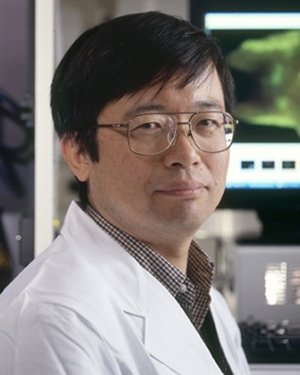Hisataka Kobayashi's Probe Tags Cancer Cells Instantly
By wchung | 04 Nov, 2025
Hisataka Kobayashi’s team has developed a spray that can quickly tag cancer cells with fluorescence for easy identification. The spray acts within one minute, allowing surgeons to use it during a procedure to ensure they’ve removed all cancerous tissue.
Kobayashi chose the enzyme y-glutamyl transpeptidase, abundant in tumor cells, as the target that activates the probe’s fluorescence. The probe contains a chemical target of the tumor enzyme, causing the enzyme to cleaves the chemical on contact and activate the fluorescence as a beacon for surgeons. The probe acts far more quickly than others because its target enzyme is located on the cell surface. The actual reaction occurs in seconds. Earlier probes targeting molecules inside cancer cells can take hours or even days to build sufficient mass to become visible.
The drawback is that some cancer cells don’t express y-glutamyl transpeptidase. Some don’t express enough of it to produce a visible level of fluorescence. But the probe is thought to work well for ovarian, cervical, gastric and colon cancers, among others, especially those that spread into surrounding cavities, making detection and removal difficult for surgeons.
The spray form of the probe is more efficient because it can be applied locally in doses that are about 1,000 to 10,000 times lower than amounts that would have to be ingested orally, says Kobayashi. His team at the National Cancer Institute has already begun to evaluate the spray in human tumor samples and will start full clinical trials in a few years. Their study demonstrating the spray in cancer cells in mice was published last last week in Science Translational Medicine.
Earlier this month Kobayashi had also reported developing a fluorescent dye that can be used to kill cancer cells by burning holes in their membranes without harming surrounding tissue. The study was published in Nature Medicine.
Hisataka Kobayashi is chief scientist of the Molecular Imaging Program at the National Cancer Institute. He earned an MD in 1987 and PhD in immunology and medicine in 1995 from the Kyoto University. His work is focused on developing novel molecular imaging agents and technologies for targeting cancers. He has published over 200 scientific articles in clinical and preclinical bio-medical imaging over the last 20 years.

Hisataka Kobayashi is the chief scientist in the Molecular Imaging Program at the National Cancer Institute.
Asian American Success Stories
- The 130 Most Inspiring Asian Americans of All Time
- 12 Most Brilliant Asian Americans
- Greatest Asian American War Heroes
- Asian American Digital Pioneers
- New Asian American Imagemakers
- Asian American Innovators
- The 20 Most Inspiring Asian Sports Stars
- 5 Most Daring Asian Americans
- Surprising Superstars
- TV’s Hottest Asians
- 100 Greatest Asian American Entrepreneurs
- Asian American Wonder Women
- Greatest Asian American Rags-to-Riches Stories
- Notable Asian American Professionals

